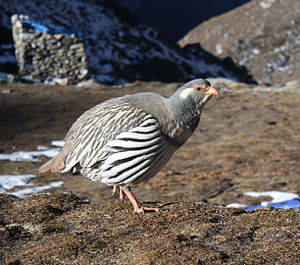Tibetan King Chicken
| Tibetan King Chicken | ||||||||||
|---|---|---|---|---|---|---|---|---|---|---|

Tibet King Chicken ( Tetraogallus tibetanus ) on Mera Peak in Nepal |
||||||||||
| Systematics | ||||||||||
|
||||||||||
| Scientific name | ||||||||||
| Tetraogallus tibetanus | ||||||||||
| Gould , 1854 |
The Tibetan king chicken ( Tetraogallus tibetanus ) is a species of bird from the genus of the king chickens ( Tetraogallus ) in the family of pheasants (Phasianidae), which belong to the order of the galliformes . It is a mountain bird that can be found all year round in the high mountains of Tibet, Bhutan, Nepal, India and Tajikistan and lives exclusively on the ground.
Due to the large distribution area and the apparently stable population, the Tibetan king hen is classified as not endangered by the IUCN .
Appearance
The Tibetan king chicken reaches a body length of 50 to 60 centimeters. Like the Caucasian king chicken, it is strongly built with a large head, thick neck and long tail. The gender dimorphism is only slightly pronounced.
In the adult males, the sides of the neck, the rear neck and the top of the head are black-gray. The front back and the collar have a reddish tinge. The rest of the upper side of the body is gray with a fine cream-colored radiation pattern. On the back of the back and the rump there are short, white or reddish longitudinal stripes, which are formed by the edges of the feather tips.
Behind the eye there is a wide white stripe four to five centimeters long. The throat and front neck are white and separated from the white of the front by a gray band. The lower part of the chest and the belly are white with a longitudinal drawing of black stripes formed by feather hems.
Adult females are generally colored like the males, but their breasts are less white.
distribution and habitat

The distribution area of the Tibetan King Chicken extends over the Pamir as well as the highlands of Tibet and the adjacent mountain systems Kunlun Shan , Himalaya and Nan Shan . Like the other king fowl, it keeps mountain slopes and undertakes only slight seasonal migrations. In snowy winters, however, the lower sections of the slope descend at altitudes of 3900 to 4000 meters. In summer it is at high altitudes. In the Pamir, for example, it lives at altitudes above 4,300 meters during the summer.
Subspecies
Within the large distribution area, seven subspecies are recognized, which differ slightly in their coloration:
- T. t. tibetanus Gould , 1854: Distribution area Pamir, Karakoram , Ladakh and the northwestern part of the Kunlun Shan
- T. t. tschimenensis Sushkin , 1926: Distribution area Kunlun Shan
- T. t. centralis Sushkin , 1926: distribution area southern Tibet
- T. t. przewalskii Bianchi , 1907: Distribution area northeast Tibet and Nan shan
- T. t. henrici Oustalet , 1891: Distribution area Sino-Tibetan Mountains
- T. t. aquilonifer Meinertzhagen, R. & Meinertzhagen, A , 1926: Distribution area Sikkim and the adjacent parts of the Himalaya
- T. t. yunnanensis Yang & Xu 1987 in the north of Yunnan
Way of life
The winter food of the Tibetan king chickens consists of buds and dry stems of primroses, hornbill, catchweed, bluegrass, fescue, catchweed, vetch, saxifrage, cinquefoil, foxtail and similar alpine plants. In summer they also eat green leaves, young shoots and flowers of various perennials. In autumn, in addition to dry parts of the plant, they also consume large numbers of rhizomes and tubers of various plants.
In the winter months, the Tibetan king chickens live in small flocks. These dissolve in spring, so that from the beginning of May the birds can mainly be observed in pairs. The oviposition seems to take place in the entire distribution area in the second half of May. The nest is a shallow hollow that is only slightly padded with parts of the surrounding plants. It is located in the middle of the rocks on a small area with a loamy bottom.
The full clutch consists of four to seven eggs. The incubation period is not known. The rooster stays near the nest during the breeding season. Both parents are involved in guiding the young birds.
supporting documents
literature
- RL Potapov, VE Fling (ed.): Handbook of the birds of the Soviet Union. Volume 4: Galliformes, Gruiformes. Aula Verlag, Wiesbaden 1989, ISBN 3-89104-417-8
Single receipts
- ↑ IUCN on the Tibet King Chicken, accessed May 30, 2013
- ^ Potapov & Fling, 1989, p. 84
- ^ Potapov & Fling, 1989, p. 85
- ^ Potapov & Fling, 1989, p. 87
- ^ Potapov & Fling, 1989, p. 86
Web links
- Tetraogallus tibetanus in the endangered Red List species the IUCN 2012. Posted by: BirdLife International, 2012. Accessed May 31, 2013.
- BirdLife International: Species Factsheet - Tibetan Snowcock ( Tetraogallus tibetanus ) . Retrieved May 31, 2013.
- Videos, photos and sound recordings of Tibetan Snowcock (Tetraogallus tibetanus) in the Internet Bird Collection
- Tibetan King Chicken ( Tetraogallus tibetanus ) at Avibase; accessed on May 31, 2013.
- Tetraogallus tibetanus in the Integrated Taxonomic Information System (ITIS). Retrieved May 31, 2013.
- xeno-canto: Sound recordings - Tibetan Snowcock ( Tetraogallus tibetanus )
